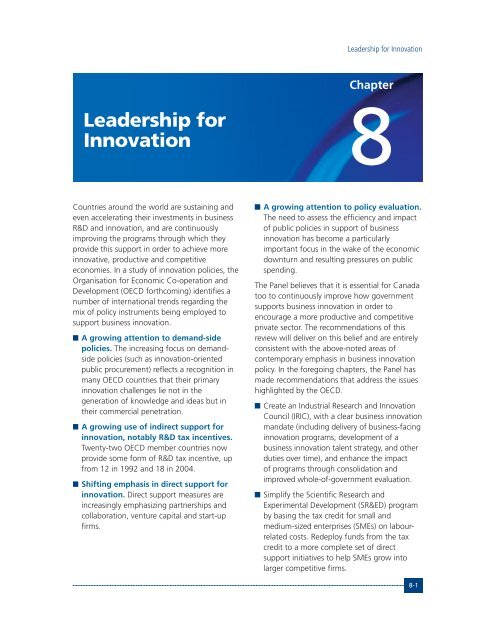Innovation Canada: A Call to Action
Innovation Canada: A Call to Action
Innovation Canada: A Call to Action
Create successful ePaper yourself
Turn your PDF publications into a flip-book with our unique Google optimized e-Paper software.
Leadership for <strong>Innovation</strong>ChapterLeadership for<strong>Innovation</strong>8Countries around the world are sustaining andeven accelerating their investments in businessR&D and innovation, and are continuouslyimproving the programs through which theyprovide this support in order <strong>to</strong> achieve moreinnovative, productive and competitiveeconomies. In a study of innovation policies, theOrganisation for Economic Co-operation andDevelopment (OECD forthcoming) identifies anumber of international trends regarding themix of policy instruments being employed <strong>to</strong>support business innovation.A growing attention <strong>to</strong> demand-sidepolicies. The increasing focus on demandsidepolicies (such as innovation-orientedpublic procurement) reflects a recognition inmany OECD countries that their primaryinnovation challenges lie not in thegeneration of knowledge and ideas but intheir commercial penetration.A growing use of indirect support forinnovation, notably R&D tax incentives.Twenty-two OECD member countries nowprovide some form of R&D tax incentive, upfrom 12 in 1992 and 18 in 2004.Shifting emphasis in direct support forinnovation. Direct support measures areincreasingly emphasizing partnerships andcollaboration, venture capital and start-upfirms.A growing attention <strong>to</strong> policy evaluation.The need <strong>to</strong> assess the efficiency and impac<strong>to</strong>f public policies in support of businessinnovation has become a particularlyimportant focus in the wake of the economicdownturn and resulting pressures on publicspending.The Panel believes that it is essential for <strong>Canada</strong><strong>to</strong>o <strong>to</strong> continuously improve how governmentsupports business innovation in order <strong>to</strong>encourage a more productive and competitiveprivate sec<strong>to</strong>r. The recommendations of thisreview will deliver on this belief and are entirelyconsistent with the above-noted areas ofcontemporary emphasis in business innovationpolicy. In the foregoing chapters, the Panel hasmade recommendations that address the issueshighlighted by the OECD.Create an Industrial Research and <strong>Innovation</strong>Council (IRIC), with a clear business innovationmandate (including delivery of business-facinginnovation programs, development of abusiness innovation talent strategy, and otherduties over time), and enhance the impac<strong>to</strong>f programs through consolidation andimproved whole-of-government evaluation.Simplify the Scientific Research andExperimental Development (SR&ED) programby basing the tax credit for small andmedium-sized enterprises (SMEs) on labourrelatedcosts. Redeploy funds from the taxcredit <strong>to</strong> a more complete set of directsupport initiatives <strong>to</strong> help SMEs grow in<strong>to</strong>larger competitive firms.8-1
















